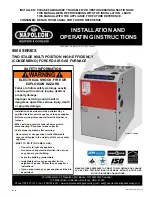
26
3. INPUT = GAS HTG VALUE x 3600 SEC. PER CUBIC
FOOT (3600 is a conversion factor- 3600 seconds = 1
hour.)
Example: Natural gas with a heating value of 1000 BTU
per cubic foot and 34 seconds per cubic foot as deter-
mined by Step 2, then:
Input = 1000 x 3600 x 34
= 106,000 BTU per Hour
NOTE: BTU content of the gas can be obtained from the
gas supplier.
This measured input must not be greater than the input
indicated in Specification Sheet.
4. Relight all other appliances turned off in Step 1. Be sure
all pilot burners are operating.
CHECK BURNER FLAMES
Flames should be stable, soft and blue, (dust may cause
orange tips but they must not be yellow), extending directly
outward from the burners without curling, floating or lifting
off.
CHECK TEMPERATURE RISE
Check the temperature rise through the unit by placing
thermometers in supply and return air registers as close to
the furnace as possible. Be sure the thermometers do not
“see” the heat exchangers or false readings could be
obtained.
1. All registers must be open, all duct dampers must be in
their final (fully or partially open) position, and the unit
operated for 15 minutes before taking readings.
2. The temperature rise must be within the range specified
on the rating plate or Specification Sheet.
NOTE: Air temperature rise is the temperature difference
between supply and return air.
With a properly designed system, the proper amount of
temperature rise will normally be obtained when the unit is
operated at rated input with the “as shipped” blower speed.
If the correct amount of temperature rise is not obtained, it
may be necessary to change the blower speed. A faster
blower speed will lower the temperature rise. A slower
blower speed will increase the temperature rise.
NOTE: Blower speed must be set to give the correct air
temperature rise through the furnace as marked on the
rating plate.
CHANGING BLOWER SPEEDS
WARNING
To avoid death or personal injury due to
electrical shock, turn off power to the furnace
before changing speed taps.
All furnaces ship at high speed for cooling and the speed
listed in Specification Sheet for heating. These speeds
should be adjusted by the installer to match the job require-
ments. See Specification Sheet for details.
Connect the correct motor leads to the COOL, HEAT, and
PARK terminals. If heating speed will equal cooling speed,
use the jumper wire provided. All unused motor leads that
are not connected to “PARK” terminals on the control must
be taped to prevent shorts.
Figure 42
High Limit Control
CHECK HIGH LIMIT CONTROL
WARNING
To prevent death, personal injury, property
damage or premature failure of heat
exchanger, do not adjust the limit control
(factory preset).
Check limit control operation after 15 minutes of operation
by blocking the return air grille(s).
1. After several minutes the burners must go OFF. Blower
will continue to run.
2. Remove air restrictions and burners will relight after a
cool down period of a few minutes.
Adjust the thermostat setting below room temperature
1. Burners must go off.
2. Circulating air blower will continue to run for 60, 90, 120
or 180 seconds as set.
IMPORTANT NOTE: This unit must not be used as a
construction heater during the finishing phases of construc-
tion of a new structure. This type of use may result in
premature failure due to extremely low return air tempera-
tures and exposure to corrosive or very dirty atmospheres.
TO TURN OFF FURNACE
1. Set the thermostat to lowest setting.
2. Turn off the electrical power supply to the furnace.
3.
Honeywell Model VR-8205, or White Rodgers Model
36E36, or Robertshaw Model 7222: Turn the gas
control knob clockwise
to the OFF position.
The knob should turn easily. Do not use excessive
force.
White Rodgers Model 36E22: Push switch to the OFF
position.
4. Close manual gas shutoff valve external to the furnace.
5. Replace the door on the unit.

































